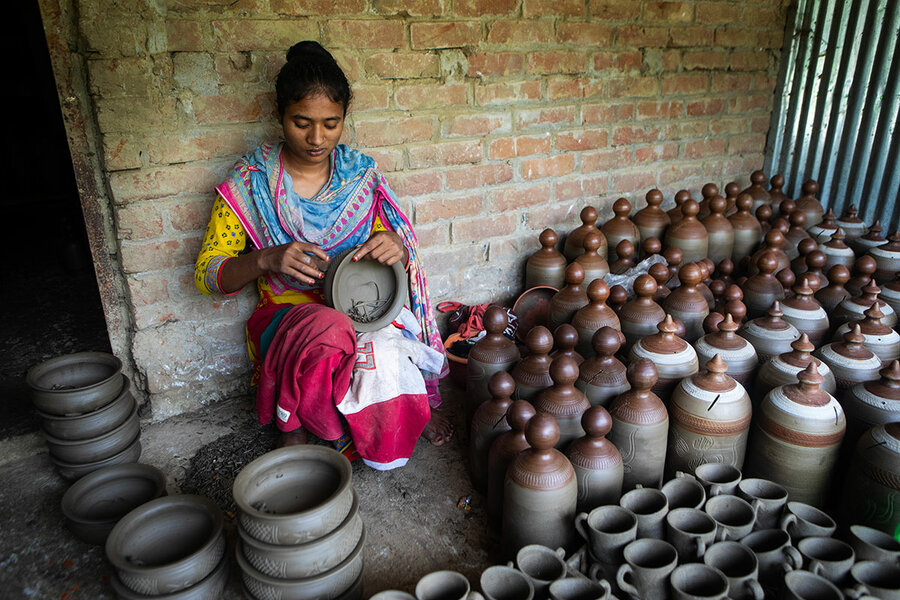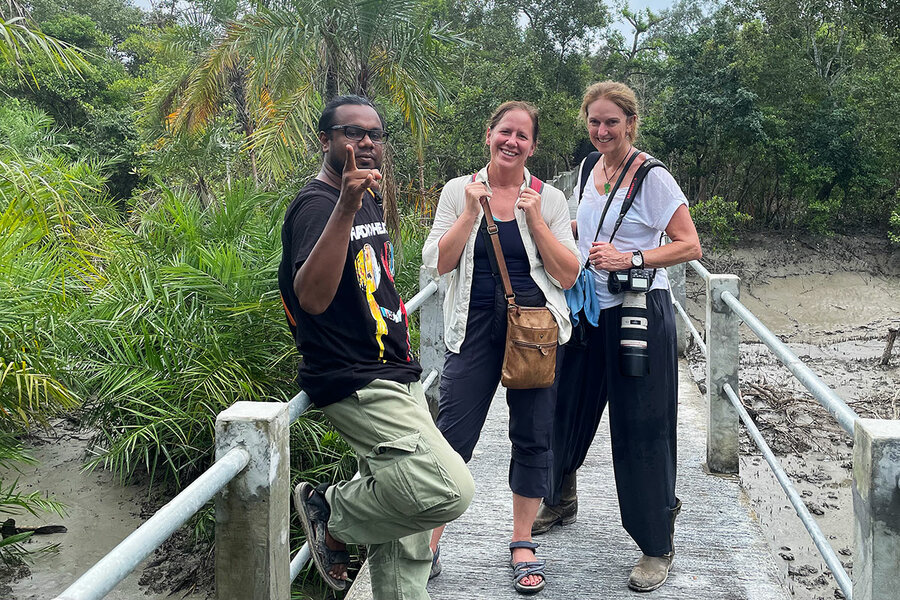Letter from Kushtia: Getting a rock star’s view into Bangladesh
Loading...
| Kushtia, Bangladesh
When I asked Sina Hasan, lead vocalist of Bangla Five and local reporting partner extraordinaire, where we could do a quick overnight during a reporting trip in Bangladesh, he recommended Kushtia.
I’d never heard of it, but that’s not saying much. Bangladesh is barely on the tourist map. Travelers who do come here typically tread a well-worn path to Cox’s Bazar or the Sundarbans mangrove forest.
Why We Wrote This
A story focused onA day in Kushtia, Bangladesh – a city that’s off the beaten path but brimming with history and culture – provided Monitor journalists a reprieve, as well as a deeper appreciation for one of the region’s youngest nations.
“It’s my favorite place in all of Bangladesh,” Sina told photographer Melanie Stetson Freeman and me, “because it’s the heart of Bengali culture.”
This was exactly what we needed – after a harrowing trip, we still had everything to learn about the country’s art, literature, and music.
As we strolled along the Gorai River, we saw that, in addition to being a hub for Bengali writers and artisans, Kushtia is known as the resting place of spiritual leader Lalon Shah. Born in the late 18th century in undivided Bengal, then an epicenter of the burgeoning freedom movement against British rule, the musician and mystic was inspired by the peaceful coexistence of Hindu, Buddhist, and Sufi traditions in Kushtia.
Today, the city brims with music and creativity, and thousands attend the annual festival dedicated to Lalon Shah’s work.
“This music is in our blood, it’s who we are,” says Sina.
It’s not every day that your fixer is a rock star. So when I asked Sina Hasan, lead vocalist of Bangla Five and local reporting partner extraordinaire, where we could do a quick overnight during a Monitor reporting trip in Bangladesh and he recommended Kushtia, I didn’t question it.
I’d never heard of Kushtia, but that’s not saying much. Bangladesh is barely on the tourist map. And for the travelers who do come here, they tend to tread a well-worn path to Cox’s Bazar, the longest uninterrupted beach in the world; the pretty tea estates of Sylhet; or the Sundarbans mangrove forest, home of the endangered Bengal tiger.
“It’s my favorite place in all of Bangladesh,” Sina told photographer Melanie Stetson Freeman and me, “because it’s the heart of Bengali culture.” Home to the mystic and musician Lalon Shah, whose spiritualist movement brought Sina here in the first place while he was doing his master’s degree, Kushtia brims with music, creativity, tolerance, and peace.
Why We Wrote This
A story focused onA day in Kushtia, Bangladesh – a city that’s off the beaten path but brimming with history and culture – provided Monitor journalists a reprieve, as well as a deeper appreciation for one of the region’s youngest nations.
It was exactly what we needed after a reporting trip in September that tested our tolerance for heat and included harrowing driving across the world’s largest delta. And we had everything to learn about the art, literature, and music of Bangladesh.
We started with the artists. Our first morning we stopped at the home of Krishna Kanta Das, who 40 years ago began SM Handicraft, a cottage shop that makes decorative tiles made of terra cotta. On this morning, an elderly woman used a bamboo stick to carve the image of an Indian folk dancer into a block. Sometimes the tiles are tiny, fitted onto homemade frames made out of gamari wood.
“If we stopped doing this no one else would,” says Mr. Das, as his wife and daughter serve chai and cookies on terra cotta saucers. “We see a role in saving this art form.”
We visited pottery makers and weavers making lungis, a cloth sarong popular in the countryside. Everywhere it seemed, in sun-dappled studios, artisans were hard at work.
Our next stop was in the nearby community of Shilaidaha, where Bangladesh’s most famous author spent time creating some of his most influential works. On our way to the residence of Nobel Laureate poet Rabindranath Tagore, as we passed by jute cultivation at various stages, Sina told us that to him, Mr. Tagore is the “God of Bengali art and music.” He is the man who “transformed music and literature into modern practice,” he says.
But when we arrived at the residence, it was closed. So instead we looked through the gates at the gardens, hearing from Sina about the impromptu music sessions that take place when it’s open. We tried kulfi, an ice cream typical of this region made from milk film, cinnamon, and other spices. When we left, we were asked to pose for a series of selfies, something Melanie and I were asked to do dozens of times by very friendly strangers across the country.
After lunch at a vegetarian Indian restaurant, we visited a tea stall along the Gorai River – where orange and hibiscus-flavored teas are brewed and sipped along the quay – and then we arrived where most start on a trip to Kushtia: the onion-shaped temple of mystic and musician Lalon Shah.
His mysterious beginnings – documented in a tiny museum near the temple – started in the late 18th century in undivided Bengal, then an epicenter of the burgeoning Indian freedom movement against British rule. Here, Hindu, Buddhist, and Sufi traditions co-existed tolerantly and inspired Lalon Shah’s music and thought until he died, according to legend, at 116 years old.
The Bauls, or mystic entertainers, live on another century later. That evening we joined some of them, gathered at sundown, each taking a kernel of rice and swallowing it without it touching the teeth, as tradition guides. We then went to the lakeside where they, sitting in a circle under a pavilion, played their music late into the evening. Each year thousands arrive in Kushtia for an annual festival paying homage to Lalon Shah’s music and mysticism. “This music is in our blood, it’s who we are,” says Sina.
I’m thinking of his words right now as I listen on Spotify to Bangla Five – specifically their song “Lukao,” a melodic track that speaks of solitude. To the casual visitor, Kushtia itself doesn’t look so very different from any other mid-sized city in Bangladesh. But it’s the meaning of Kushtia that matters to those who love it.
Last month, Sina returned to Kushtia for his 40th time, but this time with his band invited to play at an outdoor concert drawing a crowd of 4,000. “Every art practitioner in Bangladesh has a dream to visit Kushtia at least for once in life,” he says. “It’s very prestigious to be invited to Kushtia, and we feel so honored.”















